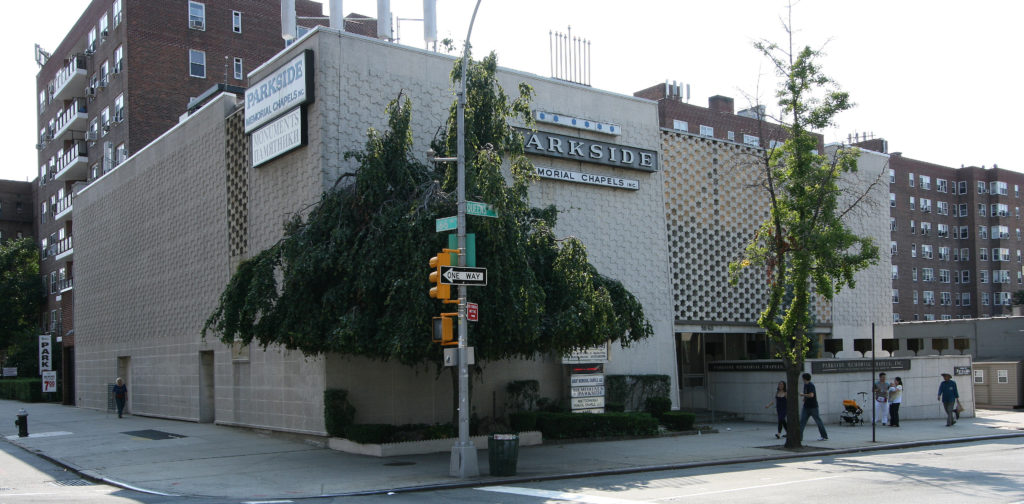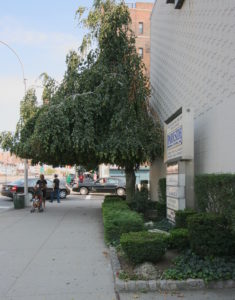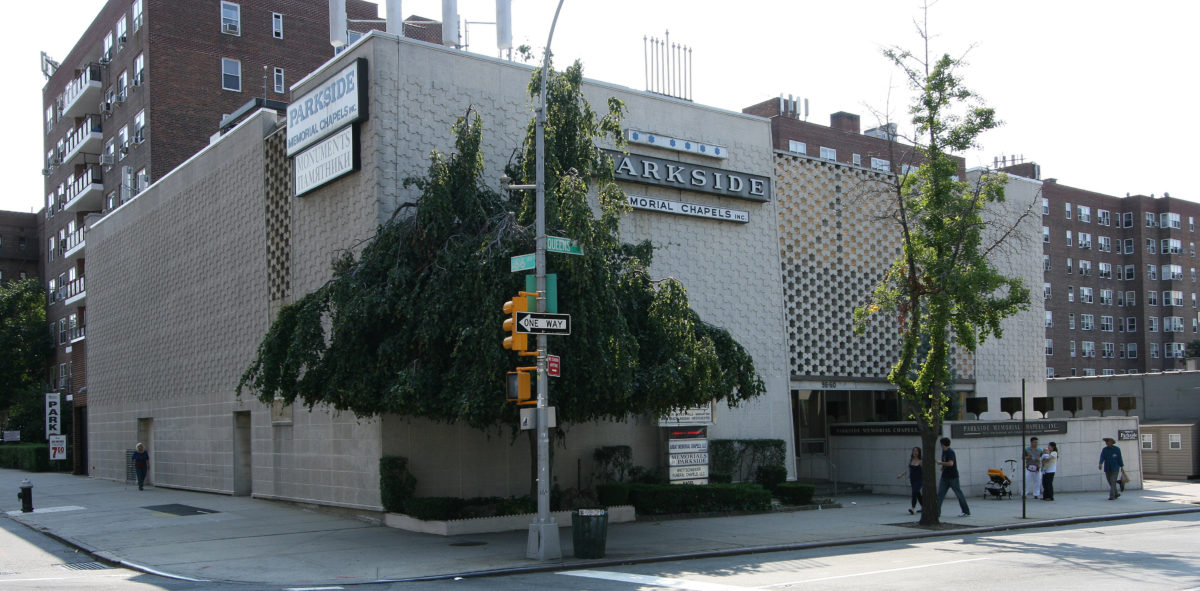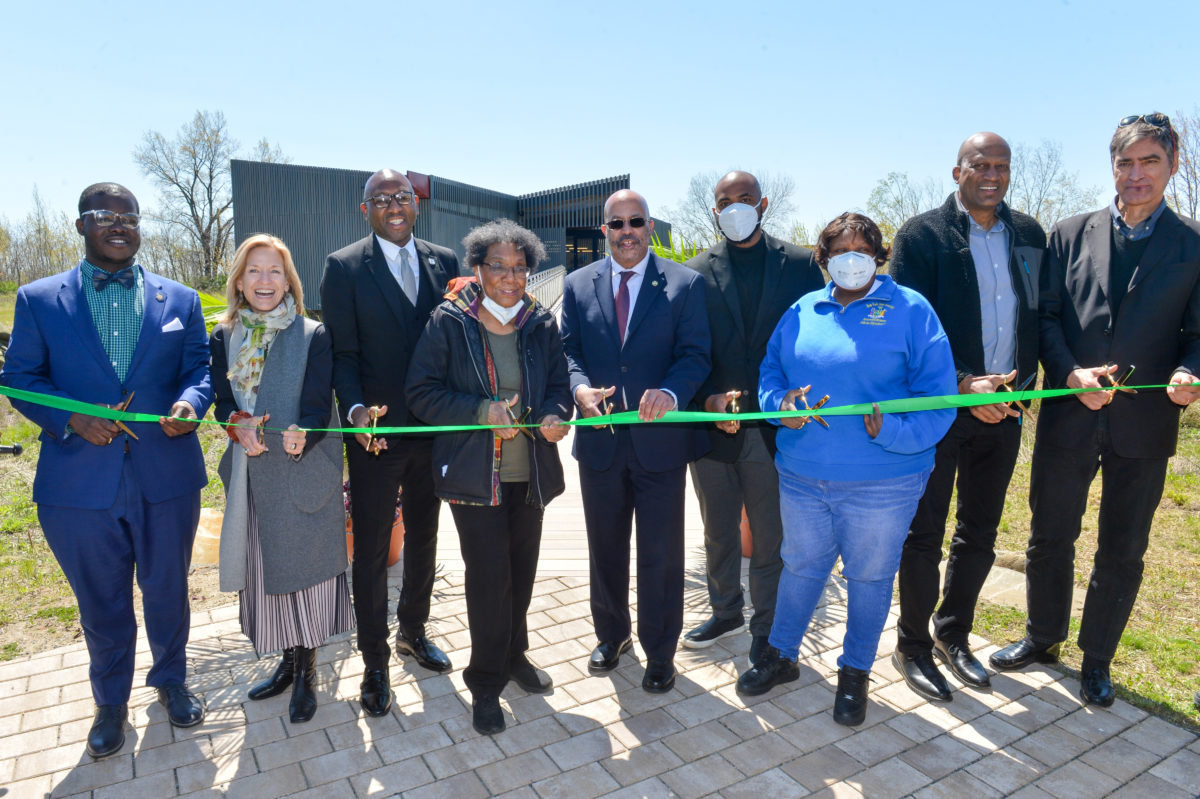Perlman: On a Mission to Reintroduce Local Weeping Beech Trees
By Michael Perlman
mperlman@queensledger.com

A rare Weeping Beech in front of the now demolished Parkside Chapel. (Photo: Michael Perlman)
Every community has at least one tree that is the talk of the town, although all varieties uniquely contribute to a larger audience of trees, and every resident has their favorites.
Since 1961, a rare, healthy and most graceful Weeping Beech tree has stood in front of Parkside Memorial Chapel at 98-60 Queens Boulevard in Rego Park.
As this American Institute of Architects-recognized mid-century modern chapel was demolished in January despite a movement to preserve a tributary site to the Sinai desert of Moses, the Israelites and the Ten Commandments, workers assured residents that the Weeping Beech tree would remain.
Then one day, they cringed to observe their favorite tree being chopped down.
Months have passed, and Rego Park resident Jennifer Verdon courageously launched a fundraiser to plant five new Weeping Beech trees throughout the community in its spirit, while restoring a native species that is a novelty.
The goal is to raise $10,000, since each tree accompanied by precise planting costs an average of $2,000.
“I live behind what was the beautiful landmark-worthy Parkside Memorial Chapel designed by the Viennese architect Henry Sandig and Robert Kasindorf, and bore witness to its destruction for overdevelopment, which was devastating. I went outside to speak to the crew weekly, and they assured me that this rare Weeping Beech tree would be safe,” she said.
“I watched for a couple of months as the tree was teetering on the edge of the demolition site, hoping for the best. One day I came home, looked out my window, and burst into tears when I realized it was gone. I felt so betrayed and upset, that I knew I had to do something.”

The once cherished Weeping Beech tree.
The Weeping Beech, known as “Fagus Sylvatica,” is characterized by its shape with sweeping, pendulous branches. The distinctive Pendula variety comes in mushroom and fountain forms. Green leaves become yellow-gold in the fall. Come winter, the fractal nature of its branches is a showstopper.
Whenever Verdon would pass by Parkside Chapel and the tree, she felt fortunate to see it daily.
“I loved the whole corner so much, and felt it was really rare and special. Now I need to take a trip over to Weeping Beech Park in Flushing to get my Weeping Beech fill. That tree was rooted there over 151 years ago,” Verdon said.
She began brainstorming about a variety of potential local sites, where they would be highly visible and planting conditions would be most suitable.
She said, “I need to speak with the Parks Department, arborists, dendrologists and horticulturists who know a lot about these types of trees to find the best accommodations. They need a lot of sun and can grow very large. I’d also love to take suggestions from our community, as they know the area best.”
Verdon is also calling for the preservation and stewardship of other trees.
“Trees improve the quality of water, soil, and air by removing pollutants, help with noise reduction, and lower the temperature,” she said.
“They also reduce the amount of stormwater runoff, which reduces erosion and pollution in our waterways, and may reduce the effects of flooding. They also provide food, protection and homes for many beautiful birds and animals.”
The movement to restore Weeping Beech trees to the local landscape is already gaining traction.
“It’s sad to see a nice tree, especially a rare Weeping Beech, being destroyed,” Forest Hills resident James Civita said. “They supposedly all came from the one in Flushing that had landmark status in Weeping Beech Park.”
A prominent horticulturist, Samuel Bowne Parsons (1819-1907) obtained a seedling from a nobleman’s estate in Belgium and transported and planted it on his nursery’s grounds.
This 60-foot high and 80-foot diameter tree gave birth to generations of Weeping Beeches nationally, and potentially the tree that was in front of Parkside Chapel.
“When I used to walk by that beautiful Weeping Beech tree of Rego Park, it made my heart sing, as it was an elegant lady,” Forest Hills resident Philomena Rubin said.
She envisions having the new Weeping Beech trees planted in MacDonald Park, Parker Towers and at Our Lady Queen of Martyrs.
“Having trees helps keep us shaded and gives the birds a home. They are lovely to look at especially since we live in a concrete jungle,” she continued.
Rubin was first to donate to the fundraiser, and encourages anyone who can to pitch in.
Rego Park resident Irene Schaub said, “I not only enjoyed the beautiful tree’s form for the two decades I lived here, but I literally would dash under it because of the cool shade it provided on that sunny stretch of Queens Boulevard. I am so saddened to see it go.”
She proposes the Horace Harding and Junction Boulevard vicinity for Weeping Beech trees, after learning about its development plans.
Additionally, she envisions any spot along Queens Boulevard that is overly sunny as a perfect candidate. “Considering climate change, there should literally be a law that includes greenery in every project built in our urban environment, as well as provisions made for the maintenance of trees,” she added.
Another fan is Emily Otalora of Forest Hills. She said, “There is a calming serenity Weeping Beech trees provide when the gentle breeze tickles their vine-like branches creating a natural soothing soundtrack. A peaceful rhythm washes over you, and for a brief moment blocks out the cacophony of the city noises, making you forget that you are not in the middle of the woods, but in New York City.”
Otalora is from the school of thought that if a tree is healthy, it should be preserved.
Referencing the larger picture, she explained, “As someone who has experienced two sewer backups in 15 years, and tedious rebuilding as a result of all our greenspace getting paved over with concrete, it saddens me to see plant life being considered an afterthought, when long-term green spaces do a lot for the community. Let’s also bring back native plant life, especially if it can survive the longhorn beetle.”
For Crystal Ann, who works in Forest Hills, she smiles if she passes a Weeping Beech tree. She said, “They’re very majestic. I love their fullness and their color. They have a very magical feel. I think Forest Hills Gardens would be a great place to plant these beautiful trees, along with Forest Park and Union Turnpike, where the big patches of grass are.”
She continued, “These trees, along with other trees, help fight global warming and produce oxygen and much needed shade and beauty to our neighborhood.”
The public can donate to Verdon’s fundraiser by visiting https://www.gofundme.com/f/weeping-beech-fundraiser-replace-demolished-trees or https://gofund.me/76df45dd.





